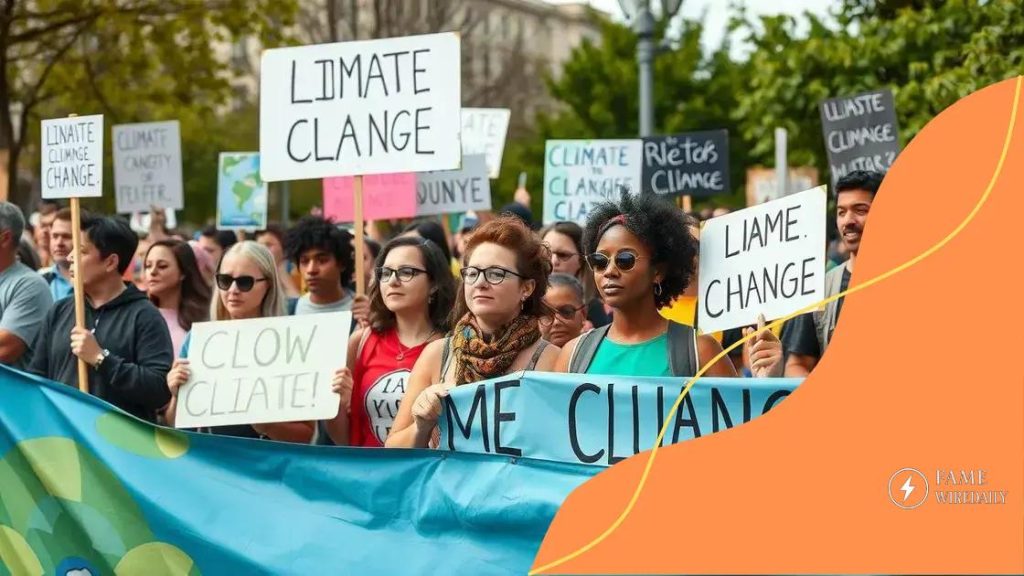Climate change protests: the rise of grassroots activism

Anúncios
Climate change protests are global public demonstrations advocating for urgent action against environmental issues, increasingly led by youth and incorporating digital activism to demand change and amplify diverse voices.
Climate change protests have become a powerful voice in advocating for environmental justice. As communities rally together, it’s essential to understand their origins and impact. What drives this urgent call for change?
Anúncios
What are climate change protests?
Climate change protests are public demonstrations aimed at raising awareness and demanding action on the climate crisis. These protests bring together people of all ages who are passionate about preserving our planet for future generations.
One of the most significant aspects of climate change protests is their focus on urgent action. Many participants believe that current measures to address climate change are insufficient. They advocate for stronger policies and greater commitment from governments around the world. But what drives these movements?
The origins of climate change protests
The environmental movement has deep roots, but recent events have sparked larger gatherings. For instance, the Fridays for Future movement started with a single student, Greta Thunberg, who began striking from school to demand climate action. Her actions inspired millions worldwide.
Anúncios
Key elements of these protests
Protests often include vibrant displays of creativity and solidarity. Demonstrators use colorful signs, chants, and art to convey their messages. Here are some key elements often seen:
- Creative signs and banners calling for climate justice
- Organized marches through city centers
- Guest speakers sharing personal stories and scientific data
- Use of social media to raise awareness
Furthermore, these protests serve as a platform for marginalized voices, amplifying those who are most affected by climate change, such as indigenous communities and low-income populations. By focusing on social justice, they emphasize that the fight for climate action is also a fight for human rights.
In essence, climate change protests are not just about environmental issues; they encompass broader themes of justice and equity. As more people join in, the calls for accountability grow louder, pushing for systemic changes that can mitigate the climate crisis.
The role of youth in environmental activism
The involvement of youth in environmental activism has gained tremendous momentum in recent years. Many young people are stepping up to challenge authority and demand urgent action to combat climate change.
One of the defining features of this movement is its ability to mobilize large groups quickly. Students around the world have organized strikes, rallies, and campaigns that have captured global attention. Their energy and passion often inspire others to join their cause.
Key figures in youth activism
Several young activists have become symbols of the movement. For example, Greta Thunberg began striking from school to highlight the climate crisis, sparking a global youth movement. Other notable figures include:
- Malala Yousafzai, advocating for education and climate justice
- Autumn Peltier, a young Indigenous water protector
- Xiuhtezcatl Martinez, a hip-hop artist and environmental activist
These individuals have made significant impacts by raising awareness and encouraging their peers to participate in environmental efforts. Their stories serve as powerful reminders of the influence youth can wield when they unite for a common cause.
In addition to organizing protests, young people are leveraging social media to spread their messages far and wide. Platforms like Instagram and Twitter allow them to reach diverse audiences and share information quickly. Many youth activists create engaging content that highlights the urgency of the climate crisis, making complex issues more relatable.
Furthermore, schools and universities have become breeding grounds for activism. Many educational institutions encourage students to engage with environmental issues, leading to the formation of clubs that focus on sustainability. Here, students collaborate to devise solutions, raise funds for projects, or host events that promote climate awareness. This sense of community amplifies their efforts and fosters a commitment to advocacy.
Key movements that shaped climate policies

Several key movements have significantly shaped climate policies around the world. These movements arise from grassroots efforts and often gain the attention of global leaders.
One of the most notable movements is the Kyoto Protocol, established in 1997. This international agreement targets greenhouse gas emissions, engaging countries to commit to reducing their carbon footprints. The Protocol marked a turning point in climate action, urging nations to work together.
Global Youth Movements
In recent years, youth-led movements have emerged as a powerful force in climate activism. The Fridays for Future movement, founded by Greta Thunberg, calls for urgent climate action and accountability. Youth activists encourage governments to implement robust climate policies and often highlight the importance of involving young voices in decision-making processes.
Indigenous Rights and Climate Justice
Many movements focus on indigenous rights, recognizing the critical link between environmental protection and social justice. Indigenous groups advocate for their land rights, asserting that protecting their territories is vital for conservation efforts. By defending their rights, they also push for policies that respect the environment.
Another influential movement is Extinction Rebellion, which uses nonviolent civil disobedience to draw attention to climate issues. Their dramatic actions, such as shutting down bridges or disrupting traffic, aim to highlight the climate emergency. These acts often lead to discussions in political spheres, pushing climate policies to the forefront of public concern.
Moreover, networks like the Climate Action Network work behind the scenes to connect different advocacy groups worldwide. They address climate change by sharing resources, organizing campaigns, and creating a unified voice that demands action at local and global levels. Their collective efforts contribute significantly to shaping effective climate policies.
Challenges faced by activists today
Activists today face a range of challenges as they fight for climate justice and urgent action on environmental issues. While movements are growing, obstacles persist that can hinder progress.
One major challenge is the influence of large corporations and fossil fuel industries. These entities often resist stricter regulations and invest heavily in lobbying against climate policies. Their power can overwhelm smaller grassroots organizations trying to create lasting change. Additionally, misinformation spreads quickly, leading to confusion about climate science and the urgency of taking action.
Threats to personal safety
Another serious challenge is the personal safety of activists. Some face threats, harassment, or violence for their beliefs. Those speaking out against powerful interests may be targeted, making it difficult for them to continue their work. This environment can discourage new voices from joining the movement.
Lack of political support
Political support can also be inconsistent. While some leaders advocate for strong climate action, others prioritize economic growth over environmental protection. This divide can result in policy stagnation. Activists often find themselves pushing uphill to hold leaders accountable, demanding bold measures to combat climate change.
Moreover, the global nature of the climate crisis means that solutions require international cooperation. However, differences between countries can complicate efforts to address climate change effectively. Activists sometimes struggle to unite diverse groups with different priorities, making coordinated action more difficult.
Despite these challenges, activists remain determined. Many adapt their strategies to overcome setbacks. By building coalitions and using technology to spread their messages, they strive to keep momentum alive. The resilience shown by today’s activists is a testament to their commitment to the planet and future generations.
The future of climate activism
The future of climate activism looks both promising and challenging as new generations take the lead in advocating for environmental change. As awareness continues to grow, movements are evolving to address various aspects of climate change more effectively.
One trend in climate activism is the shift towards more inclusive approaches. Activists are recognizing the importance of addressing social justice alongside environmental issues. By collaborating with marginalized communities, activists can create initiatives that benefit everyone. This integration leads to more equitable solutions that consider the needs of vulnerable populations.
Digital activism and technology
Another significant change is the rise of digital activism. Technology plays a crucial role in connecting activists from different parts of the world. Social media platforms allow for quick sharing of information, mobilization of resources, and raising awareness about climate issues. Online campaigns can reach millions in just a matter of days.
Youth engagement in policy-making
The involvement of young people in shaping policies is another key aspect of future activism. Many youth activists are demanding a seat at the table when it comes to discussions on climate policies. They argue that their futures are at stake, and their voices matter. This push has led to initiatives that include youth representatives in legislative processes.
As climate change impacts become more evident, activists are also focusing on adapting strategies. Protests and marches continue to be essential tools, but there is increasing emphasis on lobbying for policy changes. Activists are working to influence legislation that supports renewable energy and sustainable practices.
Moreover, the collaboration between established organizations and grassroots movements fosters a more robust climate action network. This partnership can amplify messages and combine resources effectively. By joining forces, activists can create a more significant impact on both local and global levels.
FAQ – Questions About the Future of Climate Activism
What role do young activists play in climate movements?
Young activists are at the forefront of climate movements, bringing energy and a sense of urgency to address environmental issues.
How is digital technology impacting climate activism?
Digital technology allows activists to connect globally, sharing information and mobilizing support quickly through social media.
Why is inclusivity important in climate activism?
Inclusivity ensures that diverse voices and perspectives are considered, leading to more equitable and effective solutions to climate challenges.
What strategies are activists using to overcome challenges?
Activists are adapting by building coalitions, engaging with policymakers, and utilizing digital platforms to amplify their messages.





